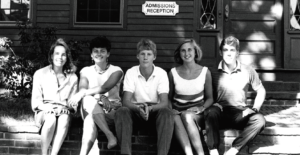
Since the program’s creation, Gold Key ambassadors, like these shown in the 1980s, have represented our School’s values to visitors.
Photo courtesy of the Archives
Today, Gold Key is a prestigious program, giving a select group of students the opportunity to tour applicants and their parents around our campus. This experience is often the prospective students’ first glimpse of Choate. But where did this program get its beginnings? And how has it evolved, developing into the efficient and carefully-coordinated system we know today?
The program technically has three beginnings. The first was at Rosemary Hall. The 1925 yearbook of Rosemary Hall describes three students, known as “The Hospites,” that had been selected by headmistress Ms. Caroline Ruutz-Rees to welcome alumni. They served tea while welcoming alumni to campus. Over time, the group grew, and their duties evolved.
By the 1960s, these young women were touring prospective families, and their name had shifted accordingly, to Student Guides. According to the Student Guide Information document, these students were expected to be “well-acquainted with Rosemary’s history, its physical plant, and all current activities and programs in progress.” Quirks of the job included detailed instructions on how to properly open a door. The document stated, “If the door swings toward you, open it and stand back to let your visitors go through. If the door swings away from you, pass on through first and then hold the door open.” The Student Guides were described as representatives of Rosemary Hall, playing an important role in the admissions process.
The second beginning also stems from Rosemary Hall. Starting sometime during the 1960s, a group known as the Gold Key Club was formed. Although similar in name to our current tour guides, their duties were a little different. These girls served as greeters at the front desk of the School, seating families and taking phone calls while on duty. According to the Duties of Members of Gold Key document from the early sixties, the girls, expected to represent the school, were told that they must “always be well-groomed: hair brushed, [and] shoes polished.” The girls welcomed prospective families, learned their names, and, after seating guests, located a guide who could show them around campus. Although their role isn’t replicated in today’s program, the leadership of the original Gold Key Club as representatives of the school helped define the respect and friendliness that the School hopes to embody in the current Gold Key program.
Gold Key’s final beginning comes from The Choate School, whose Gold Key Society began in 1957. Back then, the students’ duties were a little more extensive than today’s ambassadors. Members were expected to tour prospective students and families, pour coffee after Sunday dinner, and welcome visitors during Mother’s Day, Father’s Weekend, and Alumni Day. By 1960, the group, led by the then Director of Admissions Mr. Charles Rice, had a constitution outlining the society’s purpose, goals, requirements, and meeting times.
Eventually, all three of these programs and their respective legacies combined, along with the schools, to create an evolving group of student ambassadors. A notable director in recent history was Mrs. Liz Mitchell, who was the Gold Key Coordinator beginning in 1992 until WHEN. Known for spending most of her day working — once joking that she never left the admissions building — Mrs. Mitchell was an essential leader of the team. She was admired and beloved by students and was familiar with the application process, as all four of her children attended Choate. She found that the ambassadors brought “amazing energy and enthusiasm. Even when they’re just about out of gas, they’re here ready to help.”
The program continues to evolve with each applicant pool. For the 2013-2014 school year, the program’s expectations were tightened: if a student missed a tour, the nonappearance was counted like an absence in any academic or athletic commitment. This was meant to give students incentive to show up to their tours, as missing them caused inconvenience to other administrators and members.
The next year, tour times were expanded to include an 8:00 a.m. tour. Although this disrupted many sleep-ins, most students were happy to take on the added responsibility. They recognized the importance of the program, as well as the convenience of such an early tour, considering that many families attempt to visit two schools in one day.
Gold Key tour guides often provide the defining experience for an applicant, and can make all the difference in their final decision. However much today’s ambassadors may have changed from the very first Hospites or Gold Key members, a line from Rosemary Hall’s Student Guide information pamphlet from 1965 remains particularly fitting: “[Their] job is to give an applicant and her family the best possible picture of the school in a short time.”




